Munich U-Bahn
 | |
| Overview | |
|---|---|
| Locale | Munich |
| Transit type | Rapid transit |
| Number of lines | 8 |
| Number of stations | 96[note 1] |
| Daily ridership | 1,068,490 (2014) |
| Annual ridership | 390 million[1](2014) |
| Website | MVG - U-Bahn... |
| Operation | |
| Began operation | 19 October 1971 |
| Operator(s) | Münchner Verkehrsgesellschaft |
| Number of vehicles | 572 |
| Technical | |
| System length | 103.1 km (64.1 mi) |
| Track gauge |
1,435 mm (4 ft 8 1⁄2 in) (standard gauge) |
| Average speed | 35.6 km/h (22.1 mph) |
The Munich U-Bahn (German: U-Bahn München) system is an electric rail rapid transit network in Munich, Germany. "U-Bahn" is the German contraction for Untergrundbahn or "underground railway". The Munich U-Bahn began operation in 1971.[2] It is operated by the municipally owned Münchner Verkehrsgesellschaft (the Munich Transport Company) or MVG. The network is integrated into the Münchner Verkehrs- und Tarifverbund (the Munich Transport and Tariff Association) or MVV and interconnected with the Munich S-Bahn system. The Munich U-Bahn system currently comprises eight lines, serving 96 stations (100 stations if four interchange stations with separate levels for different lines are counted twice), and encompassing 103.1 kilometres (64.1 mi) of routes.[2]
Current routes
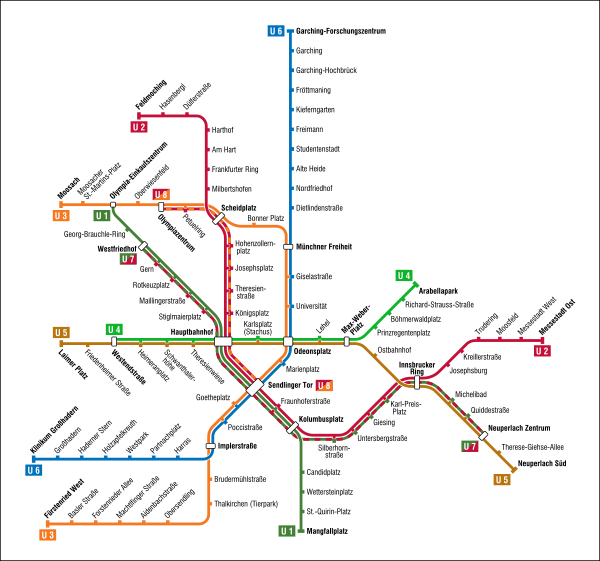
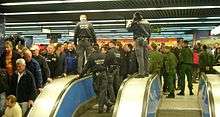
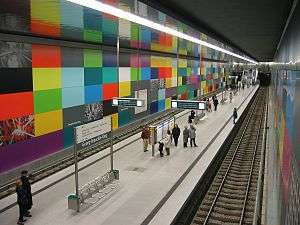
There are currently eight lines:[2]
The network has 103.1 kilometres (64.1 mi) of active route,[2] and 100 stations.[2][note 1] In 2014, 390 million passengers rode the U-Bahn.[2] The trains operate at speeds up to 80 kilometres per hour (50 mph), which is the top speed among German U-Bahns. There is no continuous operation during the night (break from 1 to 4 am, 2 to 4 am on weekends) except on special occasions such as New Year's Eve.
Currently, only the U6 line, crosses the municipal border to the town of Garching.
Except for the lines U5 and U6, all lines operate completely below ground. U5 only comes above ground at the south terminus Neuperlach-Süd, U6 on the northern section from Studentenstadt (except Garching and Garching-Forschungszentrum stations and tunnels).
There are three "line families", which consist of two lines (not counting peak hour lines) that share a common track in the city centre. The schedules of these lines are coordinated in a way, which yields regular train intervals on the common section.
Most stations have two tracks with an island platform between them. Of the single-line stations, only the stations Olympia-Einkaufszentrum (U1), Richard-Strauss-Straße (U4), Neuperlach Süd (U5), Garching-Hochbrück and Nordfriedhof (both U6) have side platforms.
At the junction stations Scheidplatz and Innsbrucker Ring, the four tracks lie in parallel on the same level with two island platforms allowing cross-platform interchange. The stations Hauptbahnhof (lower level), where U1 and U2 branch into two different lines and Münchner Freiheit (U3/U6) also have four tracks, while Implerstraße (U3/U6), Max-Weber-Platz (U4/U5) and Kolumbusplatz (U1/U2) have three: one with a side platform for outbound trains and two with a shared island platform for inbound trains.
Olympiazentrum, Fröttmaning and Kieferngarten also have four tracks each, due to the proximity of the Olympic Stadium, the Allianz Arena football stadium, and the technical base, respectively.
At Hauptbahnhof, there is a second U-Bahn station for lines U4/5 at a higher level, giving a total of six U-Bahn tracks. Sendlinger Tor, Odeonsplatz and Olympia-Einkaufszentrum also each have two stations at different levels being totally distinct stations on their own, connected with each other by escalators and elevators.
Frequency and scheduling
Most lines operate with trains running at intervals of every 5 minutes during peak hours, but due to lines overlapping, a suitable train for a journey can be as frequent as every 2 minutes.[3] Outside of peak times lines operate trains at frequencies of every 10 minutes; however, around the start of operations and after midnight the line frequency decreases to every 20 minutes or more on most lines. Again with line overlap this means that a suitable train will arrive (often much) more frequently.
U1
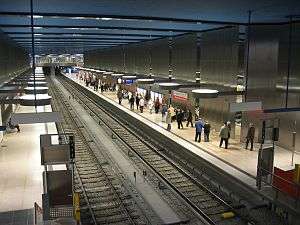
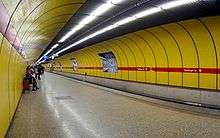
In 1980 the U1 commenced operation together with the U8 (now U2). At the beginning it was only operating on a section of U2's track. When the branch to Rotkreuzplatz was opened, it became a separate line. The line's colour is green.
Today the U1 has a length of 12.2 kilometres (7.6 mi) and 15 stations. It starts at Olympia-Einkaufszentrum in the district of Moosach. The U3 was extended to the same station (but on a different level) in 2007. On the way south it follows Hanauer Straße to Georg-Brauchle-Ring, which has been designed by Franz Ackermann, reaching Westfriedhof. It continues via Gern to Rotkreuzplatz, which was its terminus from 1983 to 1998. Below Nympenburger Straße it goes on to Maillingerstraße and Stiglmaierplatz and finally merges into the U2 track at München Hauptbahnhof.
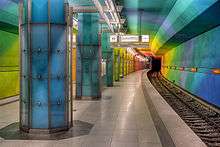
On the busy city section, U1 and U2 run with a 5-minute offset, yielding 5 minute intervals even beyond peak hours. At Central Station, it also crosses the S-Bahn and U4/U5. At the next station, Sendlinger Tor, it passes below U3/U6. There the U1/U2 platforms for each direction lie in tunnels which are apart from each other and are connected by a pedestrian tunnel.
Fraunhoferstraße, the next station, is also reached in separate tunnels, which had to be excavated using tunneling shields due to the proximity of the River Isar. However, the two tubes are connected by the platform, which demanded large pillars that are characteristic for this station. The next station, Kolumbusplatz, is a junction which has three tracks. Here the U1 branches off the U2 again.
The southbound branch line was opened in 1997 and traverses the colourful station Candidplatz, eventually reaching Wettersteinplatz. The following station, St.-Quirin-Platz has an extraordinary architecture, as it is covered by a large, shell-like structure made from glass and steel, which is drawn nearly down to track level on one side. The U1 terminates at Mangfallplatz below Naupliastraße.
U2
The route of the U2 line has undergone more changes than any of the other Munich underground lines. It also changed its name as it was first called U8. It is the only line that runs or ran on all three "line families" (U1/U2, U3/U6 and U4/U5). Today it has a length of 24.4 kilometres (15.2 mi) and 27 stations. The line's colour is red.
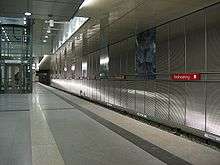
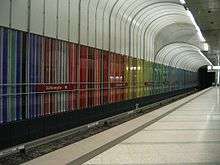
The U2 starts in the north at Feldmoching, where it connects to the S1 to Freising/Airport. The station there is decorated with rural and urban motives of Feldmoching's history. Below Hasenbergl, a district which had been known for its social problems, it goes to Dülferstraße, which provides access to the eastern Hasenbergl and a newly built area on Panzerwiese. Dülferstraße was the terminus from 1993 till 1996.
Via the stations Harthof and Am Hart, the U2 reaches Frankfurter Ring. In the tunnel between Am Hart and Frankfurter Ring, there is a white and blue wave pattern, which is the only installation of art in a Munich U-Bahn tunnel outside of stations.
After Milbertshofen station the U2 touches the U3 line at Scheidplatz, where cross-platform interchange is possible. Before the opening of the section to Dülferstraße in 1993, U2 went from Scheidplatz to Olympiazentrum, sharing the track with the U3. Through the district of Maxvorstadt the U2 continues to downtown Munich, reaching the stations Hohenzollernplatz, Josephsplatz, Theresienstraße und Königsplatz. At Königsplatz one can find artworks from the nearby Glyptothek on the platform.
At München Hauptbahnhof (Munich Central Station), the U2 meets the U1, with which it shares tracks until Kolumbusplatz (see above).
After Kolumbusplatz the U2 continues eastward and reaches the stations Silberhornstraße, Untersbergstraße and Giesing (Bahnhof), with an interchange possibility to S7 and S3. The next stations are Karl-Preis-Platz and Innsbrucker Ring, where cross-platform interchange to the U5 is possible. Until 1999, when the branch to the Messestadt stations was opened, the U2 ran from here to Neuperlach.
Via the stations Josephsburg and Kreillerstraße the U2 reaches Trudering, which features two platforms in separate tunnels, connected by two transversal tunnels. In 1994, during the construction of this section, an accident happened: the ceiling of the new tunnel collapsed due to the intrusion of water and a bus fell into the crater. Two passengers and one construction worker died and the construction was delayed.
Via Moosfeld, the U2 reaches Messestadt-West and its terminus Messestadt-Ost. These stations are located between the fairgrounds (Messestadt) in the north and a development area and the Bundesgartenschau 2005 in the south.
U3

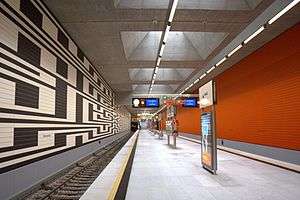
The U3 is the original Olympic line; the first section was opened for the Olympic Summer Games 1972. Today the line has a total of length of 21.2 kilometres (13.2 mi) and 25 stations. The line's colour is orange.
Today the U3 starts in the north at Moosach, Munich's 100th U-Bahn station, where you can change to the S1 to Freising/Airport. From here the line runs east to Moosacher St.-Martins-Platz and Olympia-Einkaufszentrum, where a change to the U1 is possible. After passing through Oberwiesenfeld station, the U1 reaches its original northern terminus at Olympiazentrum. From 1972 until 2010, this station was the end of the original Olympic line.
When Munich was awarded the Olympic Summer Games 1972 in 1965, the U-Bahn network concept (which was adopted only one year earlier) had to be revised to speed up the construction of a connection to the Olympic venues at Olympic grounds. The Olympic connector (now U3) was redesigned as a branch of the U6 line, because the original plan of a direct connection to the Olympic ground from Munich Central Station was not feasible in the shortness of time. This original U3 sections consists of four stations (from north to south): Olympiazentrum, Petuelring, Scheidplatz, where cross-platform interchange to the U2 (the line originally supposed to serve the Olympic venues) is possible since 1980, and Bonner Platz. After Bonner Platz the U3 reaches Münchner Freiheit, where it joins the U6 to run together through the inner city section to Implerstraße (for this section see U6 below).
After leaving the three-track junction station Implerstraße, the U3 reaches Brudermühlstraße, Thalkirchen (Zoo) and Obersendling, which is built 30 metres (98 ft) higher than the Thalkirchen station, because it is located on the "Hochufer" (western tread) of the River Isar. Here, interchange to the S-Bahn at Siemenswerke station is possible. The U3 continues west via Aidenbachstraße and Machtlfinger Straße, before reaching Forstenrieder Allee, Basler Straße, and eventually the terminus Fürstenried West. This southern-eastern section was opened on October 28, 1989, as can be seen from huge date numbers on the western entrance of Obersendling station.
U4
With only 9.2 kilometres (5.7 mi) and 13 stations, the U4 is Munich's shortest U-Bahn line. This line has originally been planned as U9 and is the only line that operates regularly with 2-train sets rather than the full 3-train set. The exceptions are Fridays in the late afternoon and during the Oktoberfest. The line's colour is mint green.
The U4 begins in the west in the Laim neighbourhood at Westendstraße station, which it shares with the U5 line. Both U4 and U5 are the only lines of a joint line "family", which only branch out on one end of the common line, as an originally planned western extension of the U4 was first put on hold and was subsequently cancelled altogether.
From Westendstraße the U4 runs east to Heimeranplatz, which connects to S7 and S20 S-Bahn lines. The next two station, Schwanthalerhöhe (originally called Messegelände, the German for "exhibition grounds"; the name was changed when the exhibition centre relocated to Riem in 1998) and Theresienwiese, are gateways to the Oktoberfest, and are therefore highly loaded during this event. Between both aforementioned stations, there is a track that links to Implerstraße to provide a connection to the depot in Fröttmaning.
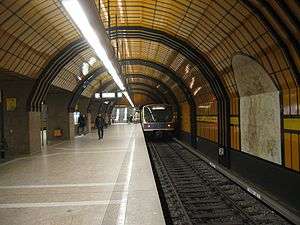
Theresienwiese is one of only two U-Bahn station in Munich (besides Fröttmaning station which serves Allianz Arena) to have the command centre booth that is opened during the Oktoberfest for supervising the masses of passengers. The south exit of the station leads to the northern entrance of Oktoberfest. U4 trains arriving from the east often terminate at Theresienwiese rather than continue to Westendstraße even during peak hours due to low traffic volume east of Hauptbahnhof.
After Theresienwiese the U4 reaches München Hauptbahnhof (Munich Central Station); passengers can transfer to U1/U2 lines as well as to all S-Bahn lines (except S20) here. The next station is Karlsplatz (Stachus) with shorter and easier connections to S-Bahn (S1 to S8). Karlsplatz is the deepest station in Munich's U-Bahn network (36 metres (118 ft) below the surface). From this point on, the U4 runs north of the S-Bahn cross-city tunnel.
After passing Odeonsplatz, where an interchange to U3/U6 trains is possible, and Lehel, the U4 crosses the River Isar in a tunnel, and reaches Max-Weber-Platz, the last station that is shares with the U5. Here, the U4 branches off to the north, while the U5 runs south.
Before terminating at Arabellapark, the U4 passes the stations Prinzregentenplatz, Böhmerwaldplatz, and Richard-Strauss-Straße, the latter being the only station of the line to be equipped with side platforms instead of an island platform.
The original plan called for an extension to Johanneskirchen station (where easy transfer to the S8 S-Bahn line would be possible) via Fideliopark, but was never built, due to low current ridership in the area north of Max-Weber-Platz. The extension of the tram line in the area in 2011 made the plan even more unlikely to materialise. A possible extension in the west to Blumenau is even more improbable.
In the evenings from around 20.40 to the close of operations, the U4 only operates between Odeonsplatz and Arabellapark.
U5
The U5 currently begins at Laimer Platz; an extension to Pasing is planned. The total length currently is 15.4 kilometres (9.6 mi). The line's signature colour is brown.
Via Friedenheimer Straße, the U5 reaches Westendstraße. From there, the U5 shares the tracks with the U4 to Max-Weber-Platz (see above).
At Max-Weber-Platz, the U5 branches off to the south to East Station (Ostbahnhof), where changing to all S-Bahn lines is possible. The next station, Innsbrucker Ring, allows cross-platform interchange to the U2.
The U5 continues south to Michaelibad, Quiddestraße, and Neuperlach Zentrum, which is the centre of the satellite town of Neuperlach, built during the 1960s and 1970s. Going on to Therese-Giehse-Allee, the U5 comes above ground and reaches its terminus Neuperlach Süd, where it allows cross-platform interchange with S-Bahn line S7. South-east of Neuperlach-Süd is a large parking yard (Betriebsanlage Süd) used to park trains which can't be parked at the technical base in Fröttmaning or within the network.
U6
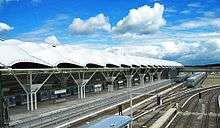
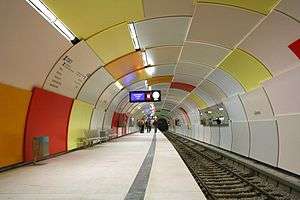
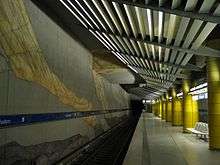
The U6 is the oldest U-Bahn line of the network and also features the oldest tunnel built: the section below the Lindwurmstraße (between Sendlinger Tor and including the station Goetheplatz) was already built 1938-1941 as part of a planned S-Bahn network. For this reason Goetheplatz has a platform longer than the standard 120 metres (390 ft). Today the line has a length of 27.4 kilometres (17.0 mi). Its signature colour is blue.
Since 2006 the northern terminus of the U6 is Garching-Forschungszentrum; via Garching it reaches Garching-Hochbrück. These three stations are outside the city limits of Munich in the city of Garching
The distance of 4.1 kilometres (2.5 mi) to the next station at Fröttmaning is the longest distance between two stations in Munich's U-Bahn network. Fröttmaning has been expanded to two island platforms and four tracks to cater for the Allianz Arena football stadium, built for the 2006 Football World Cup. The technical base of the U-Bahn is located at Fröttmaning, too. After passing Kieferngarten station, which has two island platforms as well, it crosses over a rail bridge to Freimann and Studentenstadt. Between these two stations is a connection to mainline railway tracks, which is used to bring new trains into the network. The bridge was originally used by the tram and was the only tram track to be converted to be part of the U-Bahn network. The U6 then continues underground for the rest of its way south.
Via Alte Heide, Nordfriedhof (station with side platforms), and Dietlindenstraße, the U6 reaches Münchner Freiheit, where it joins the U3 on the shared inner city tunnel.
Passing Giselastraße and Universität (University), it arrives at Odeonsplatz, where it connects to the U4/U5 lines. Continuing to Marienplatz, it crosses the S-Bahn lines. During peak hours this station is can get overcrowded, which is why additional pedestrian tunnels were built between 2003 and 2006.
At Sendlinger Tor the U3/U6 crosses the U1/U2 line, and interchange is possible. The line now uses the tunnel built in 1941 mentioned above as far as Goetheplatz. The next station, Poccistraße was added belatedly, constructed between the two existing tunnels which stayed operational. At Implerstraße the U3 and U6 separate again. To the north of the station, facing north, there is a branch to the U4/U5 at Schwanthalerhöhe, which is not used for passenger transport.
At Harras the U6 connects to the S-Bahn lines S7 and S27, and to regional trains to the south. The section via Partnachplatz and Westpark to Holzapfelkreuth was constructed for the Internationalen Gartenbauausstellung (IGA) in 1983 was therefore dubbled "flower line", which is reflected in the design of these stations. Passing Haderner Stern and Großhadern, the U6 reaches its current southern terminus at Klinikum Großhadern, where the entrance to the station is covered by a glass pyramid.
An extension to Martinsried, which is only approx. 1 kilometre (0.62 mi) west of the current terminus, is planned and agreed upon, and is supposed to open in 2019.
U7
This new booster line was added in December 2011 along with the new tram extension to St. Emmeram. The U7 runs between Westfriedhof and Neuperlach Zentrum via München Hauptbahnhof and Innsbrucker Ring: it shares the tracks with the U1 from Westfriedhof to Kolumbusplatz, the U2 from München Hauptbahnhof to Innsbrucker Ring, and the U5 from Innsbrucker Ring to its southern terminus Neuperlach Zentrum.
The stations along U7 line are Westfriedhof, Gern, Rotkreuzplatz, Maillingerstraße, Stiglmaierplatz, München Hauptbahnhof, Sendlinger Tor, Fraunhoferstraße, Kolumbusplatz, Silberhornstraße, Untersbergstraße, Giesing Bahnhof, Karl-Preis-Platz, Innsbrucker Ring, Michaelibad, Quiddestraße, and Neuperlach Zentrum.
U8
This booster line started operations in December 2013. The U8 begins in the north at Olympiazentrum and shares the tracks with the U3 as far as Scheidplatz, where it continues along the U2 tracks to München Hauptbahnhof and terminates at Sendlinger Tor. It is only running on Saturdays to ease crowding on the U2 and U3 lines, and to provide people an easier access to the Olympic Park from Munich Central Station.
The stations along U8 line are Olympiazentrum, Petuelring, Scheidplatz, Hohenzollernplatz, Josephsplatz, Theresienstraße, Königsplatz, München Hauptbahnhof, and Sendlinger Tor.
Rolling stock
Munich U-Bahn uses three different generations of electric multiple unit trains. The stock of over 550 carriages is shared between all lines.
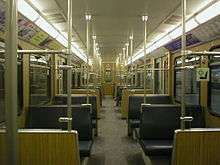
Class A trains were built between 1967 (prototypes) and 1983. The units consist of two carriages, which always remain coupled in normal operation. The double-carriage units have a length of 37.15 metres (121.9 ft), a height of 3.55 metres (11.6 ft), and a width of 2.90 metres (9.5 ft). Each unit has six doors per side and a capacity of 98 seats and standing room for 192 passengers. A total of 193 double-carriage units were delivered, of which 179 are still in use in Munich. Up to three A double-carriage units can be coupled together to form a 3/3 train (Langzug).
Class B trains were built between 1981 and 1994 to provide more stock to service the growing network in the 1980s. As with the class A trains, six prototypes were ordered. However, it took six years until the series production started and the prototypes had to be modified to match the series-production units. B units have the same size as A units but differ in the design (especially of the front window) and use three-phase current instead of direct current motors. The other difference is the door opening mechanism. On B units, the passengers only need to pull just one handle to open both doors rather than both handles as on A units. Of a total of 63 units, 57 are still in service (including one prototype), and six have been scrapped. As with A trains, up to three B double-carriage units can form a 3/3 train (Langzug). However, it is not possible to form a mixed train of A and B units, which are not compatible.
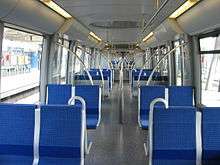
Class C units were designed in the late 1990s to replace the A units, the operation of which is hardly economically reasonable after 30 years. C units consist of six carriages allowing passage through the whole train. Only the first and last unit of each train have driver's cabs. C units can only operate as six-unit trains which have the same length as 3/3 trains. Ten trains were ordered without prototype units being previously tested, and these were finally put into service in 2002 after long delays due to technical difficulties. Eight more units were delivered in the run-up to the 2006 FIFA World Cup.
A further 21 six-car Class C vehicles, designated as C2, were ordered from Siemens Mobility in November 2010.[4] The C2 vehicles can ferry 940 passengers (as opposed to 912 by C1), have brighter lighting, monitors for passenger information, upholstered seats and coloured LEDs on the doors which signal opening and closing of the doors.[5] As of May 2015, none of the C2 carriages had entered either limited or regular service. C2 had not obtained the operating certification due to technical defects, which have largely been addressed. In addition, numerous changes in federal and state law had caused some confusions and problems with preparing the necessary documentations for the certification process.[6] In June 2016, one Class C2 vehicle was permitted to operate on the northern part of U6 line between Kiefrngarten and Garching Forschungzentrum as a trial run for the Technical Supervisory Authority (Technischen Aufsichtsbehörde i.e. TAB) of the Oberbayern government to make their assessment. On 15.11.2016, a further 4 vehicles have been added to the Class C2 fleet and they are now operating on the entire U6 line from Garching Forschungzentrum to Klinikum Grosshadern. Upon approval from TAB, 16 more Class C2 vehicles, which are currently at Siemens, can join the Munich subway fleet.[7]

Operation
Most lines are serviced by trains of three class A or B units or one class C unit (3/3 trains, "Langzug") during the day. In the early morning and the late evening, some lines are only serviced with two unit trains ("Vollzug") or single unit trains ("Kurzzug")
During the Olympic Summer Games 1972 and the visit of Pope John Paul II in 1980, rolling stock from Nuremberg, which was then compatible with Munich's stock, was used in Munich.
All stock has a maximum speed of 80 kilometres per hour (50 mph) and can be operated by Linienzugbeeinflussung (LZB), which allows short train intervals at distances as small as 80 metres (260 ft).
As the control couplings are asymmetric, only units facing in the same direction can be (electrically) coupled. As there is no way to turn units in the network, they are tied to the direction, which is why every train unit as well as every station has a "north" and a "south" end.
Accidents
Fortunately, there have been no serious accidents during service on the Munich U-Bahn. To date only three double-carriage units had to be scrapped due to accidents, all of which happened in the depot.
Two double-carriage units were destroyed on 5 September 1983, when a fan cooling the brake system was damaged. The train was taken out of service at Hauptbahnhof and parked on an underground siding track between there and Königsplatz, where it caught fire. Even though the fire brigade were quickly on the scene, the units were damaged beyond repair. Despite the tunnel ceiling being damaged in the incident, operation was quickly resumed.
Another double-carriage unit (one of the former class A prototypes) was damaged on 28 December 1995 during marshalling. It is intended to use the undamaged half of this unit as a display item in the transport department of the Deutsches Museum.
The only fatal accident in connection to the U-Bahn happened on 20 September 1994, when the ceiling of a tunnel under construction collapsed near today's Trudering station, dragging a public bus into the ensuing hole in Truderinger Straße. Two passengers were killed, as well as the construction worker, who tried to warn the bus driver.
History
Plans for an underground for Munich are quite old. In the 1930s the Nazis forbade the acquisition of new rolling stock for the Munich tramways in order to show how "insufficient" the tram system was. At that time trams were the primary means of public transportation in Munich. The Nazis made ambitious plans to change Munich into their "Reichshauptstadt der Bewegung" (Capital of the movement; the Nazi party had come to existence in Munich). This included the construction of an underground system. In the late 1930s construction started in Lindwurmstraße and Sonnenstraße, where Munich's main Lutheran-Protestant church, Matthäuskirche, was torn down because it was supposedly a "traffic obstacle" (so was the Munich's main synagogue not far away as well as the tower of the Old Town Hall). Construction was abandoned in 1941 as World War II intensified. After the war, the priority was to reconstruct the badly damaged tram system. However, even during the 1950s the Munich City Council discussed plans to run a few of the tram lines underground because the capacity for surface traffic was overstretched. In 1964 plans were, however, changed and it was decided to build a "real" underground network.
Work started on 1 February 1965 at Nordfriedhof (North Cemetery) in Ungererstraße. Today a steel girder at the first building site is a monument to Munich's first underground railway. When the 1972 Summer Olympics were awarded to Munich in 1966, construction had to be sped up to get the "Olympic" line finished on time. On 19 October 1971 the first line commenced operations between Kieferngarten and Goetheplatz with a total length of 12 kilometres (7.5 mi). On 8 May 1972 the line between Münchner Freiheit and Olympiazentrum ("Olympic line") to the venues of the Olympic Summer Games 1972 was opened, just 10 days after the Munich S-Bahn commenced operations. To satisfy demand during the Games, some DT1 trains were borrowed from Nuremberg. On 22 November 1975 the extension from Goetheplatz to Harras was opened. The network has been expanded continuously since 1980.
Line chronicle
| Opened | Line | Section | Length | New stations |
|---|---|---|---|---|
| 19 October 1971 | Kieferngarten - Goetheplatz | 12.0 km (7.5 mi) | 13 | |
| 8 May 1972 | Münchner Freiheit- Olympiazentrum | 4.0 km (2.5 mi) | 4 | |
| 22 November 1975 | Goetheplatz - Harras | 2.7 km (1.7 mi) | 2 | |
| 28 May 1978 | Poccistraße infill station | 0 km (0.0 mi) | 1 | |
| 18 October 1980 | Scheidplatz - Neuperlach Süd | 16.0 km (9.9 mi) | 18 | |
| 16 April 1983 | Harras - Holzapfelkreuth | 2.7 km (1.7 mi) | 3 | |
| 28 May 1983 | Central Station - Rotkreuzplatz | 3.3 km (2.1 mi) | 3 | |
| 10 March 1984 | Westendstraße - Karlsplatz (4.6 km (2.9 mi)) + connection tunnel to |
6.0 km (3.7 mi) | 6 | |
| 1 March 1986 | Karlsplatz - Odeonsplatz | 0.7 km (0.4 mi) | 1 | |
| 24 March 1988 | Westendstraße - Laimer Platz | 1.4 km (0.9 mi) | 2 | |
| 27 October 1988 | Odeonsplatz - Innsbrucker Ring | 4.1 km (2.5 mi) | 7 | |
| Max-Weber-Platz - Arabellapark | 3.6 km (2.2 mi) | |||
| End of 1988 | - | Enlargement of Technical Base | 0.3 km (0.2 mi) | 0 |
| 28 October 1989 | Implerstraße - Forstenrieder Allee | 6.1 km (3.8 mi) | 6 | |
| 1 June 1991 | Forstenrieder Allee - Fürstenried West | 1.9 km (1.2 mi) | 2 | |
| 22 May 1993 | Holzapfelkreuth - Klinikum Großhadern (Großhadern Clinical Centre) | 2.9 km (1.8 mi) | 3 | |
| 20 November 1993 | Scheidplatz - Dülferstraße | 5.0 km (3.1 mi) | 5 | |
| 30 June 1994 | Kieferngarten - Fröttmaning | 1.0 km (0.6 mi) | 1 | |
| 28 October 1995 | Fröttmaning - Garching-Hochbrück | 3.8 km (2.4 mi) | 1 | |
| 26 October 1996 | Dülferstraße - Feldmoching | 1.9 km (1.2 mi) | 2 | |
| 8 November 1997 | Kolumbusplatz - Mangfallplatz | 3.6 km (2.2 mi) | 4 | |
| 23 May 1998 | Rotkreuzplatz - Westfriedhof | 2.0 km (1.2 mi) | 2 | |
| 29 May 1999 | Innsbrucker Ring - Messestadt-Ost | 7.7 km (4.8 mi) | 6 | |
| 18 October 2003 | Westfriedhof - Georg-Brauchle-Ring | 0.7 km (0.4 mi) | 1 | |
| 31 October 2004 | Georg-Brauchle-Ring - Olympia-Einkaufszentrum | 0.5 km (0.3 mi) | 1 | |
| 14 October 2006 | Garching-Hochbrück - Garching-Forschungszentrum | 4.4 km (2.7 mi) | 2 | |
| 28 October 2007 | Olympiazentrum - Olympia-Einkaufszentrum | 2.2 km (1.4 mi) | 2 | |
| 11 December 2010 | Olympia-Einkaufszentrum - Moosach | 2.0 km (1.2 mi) | 2 |
Source: Municipality of Munich, Construction Office.
Extensions
Recent extensions

- U6 (North): Upgrade of Fröttmaning station
- The new Allianz Arena (football stadium) required a larger capacity of the nearby U-Bahn station. A new second platform was built and the whole station was moved north by roughly 100 metres (330 ft). For easy access to the platform, a second pedestrian bridge was built at the north end of the platforms.
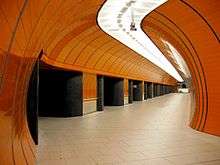
- U3/U6: Upgrade of Marienplatz station
- The increase in traffic and the new Allianz Arena also required a larger capacity of this already overcrowded pivotal transfer station. New pedestrian tunnels were built, which provide more room for passengers transferring from and to the S-Bahn. They lie parallel to the existing platforms and are connected to them by 11 portals. At the south end, they meet the transverse tunnel, where the escalators to the S-Bahn platforms are located.
Further plans
U1 (South): Extension to Harlaching Hospital via Laurinplatz
Although the plans for this extension were quite advanced, low passenger forecasts have led to its abandonment in favour of a tram or light rail from Schwanseestraße. But in 2015 and 2016, it was also announced that it will be extended to Solln.
U1 (North): Extension to Hasenbergl Nord and Fasanerie
With this extension, the U1 would end at an S-Bahn station and the Olympia-Einkaufszentrum would become the Northern Cross envisioned by the U-Bahn Office. This will also connect to the S-Bahn and the U-Bahn line U2 at Feldmoching, and it will directly terminate at Hasenbergl Nord, which will be 3 km north of the current Hasenbergl. In addition, there are also plans to extend the line to Feldomching. This was abandoned.
U2 (North): Extension to Karlsfeld
The city council of Bündnis 90 / Die Grünen and the CSU faction in the town council of Karlsfeld proposed the above-ground extension of the U2 from Feldmoching to Karlsfeld as a measure to relieve the municipality of the heavy car traffic. Moreover, this should provide a greater incentive for the employees of the large companies MAN and MTU to use public transport for their work. After initial investigations had shown a low cost-benefit ratio for this route, it was not cost-effective and was abandoned.
U3 (West): Extension to Untermenzing
This extension is planned after the U3 has been extended to Moosach, and it will go via Waldhornstraße.
U4 (East): Extension to Englschalking Bahnhof
This extension is considered in the third medium-term planning (Mittelfristprogramm) along with the plan of moving a portion of S8 line from surface to underground between Unterföhring and Leuchtenbergring stations. Whether the extension would be approved and when will it be built is not clear. The stations do include Cosimapark, Fideliopark, and Englschalking, all of which are in Messestadt.
U5 (West): Extension to Pasing
The 3.7-kilometre extension has been approved on 14 July 2015 with construction to commence in 2019. The date of completion is still not set. The cost is about 547 million euros. The route will have two stations, Willibaldplatz and Am Knie, before terminating at Pasing train station. The Willibaldplatz station is to have three platforms with third track set aside for the possible future extension into the western and southwestern area. The extension will terminate west of Pasing train station to make room for the emergency evacuation and storage: this can, too, be readily extended further west to the city boundary if the demand calls for it.
On 17 July 2015, there are citizen initiative and petition drive[8] supported by Christian Social Union (CSU) and Social Democratic Party (SPD) to extend U5 route to Freiham.[9] The reason for involvement of political parties and citizen initiative is the rejection by MVG of this further extension due to cost factor and due to existence of two S-Bahn stations in Freiham.
U6 (South): Extension to Martinsried
This extension will give access to the biotech centre at Martinsried. As the tracks will cross the municipality boundary of Munich, planning and financing is the responsibility of the municipality of Planegg or the Free State of Bavaria. The further extension of the U6 to Martinsried was approved by the district council in July 2009. The 67 million euro and approximately 1,300-metre (4,270 ft) long line was to have started operation in 2014/2015. However, complications meant that the Bavarian state cabinet did not approve the project until December 2014. Construction is now to begin at the end of 2016 and conclude by 2020.
U6 (North): Extension to Munich Airport
This would be only U-Bahn line with direct access to the Munich_Airport. At Hallbergmoos station, U6 would continue in parallel with S8 line to the airport and stop at both terminals before travelling further to Eching and Neufahrn. However, the plan was abandoned.
U9 (Bypass Line)
The route is: Martinsried – Implerstraße – Central Station – Giselastraße – Garching-Forschungszentrum
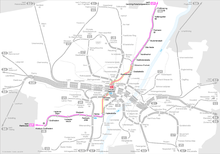
On 11 February 2014, SWM/MVG announced a detailed report for the construction of new bypass line,[10] a fourth intracity underground line, to be called the U9. The new line will relieve the overburdened U1/U2/U7/U8 and U3/U6 lines, especially the transfer stations at Sendlinger Tor (U1/U2/U7/U8 and U3/U6), Central Station (U1/U2/U7/U8 and U4/U5), and Odeonsplatz (U3/U6 and U4/U5), and will shorten the travel time between the Central Station and the Allianz Arena by removing the need to transfer at Marienplatz or Odeonsplatz. MVG is predicting tremendous growth of passenger traffic in the northern section of Munich in the next twenty years and wanted to plan accordingly. The U9 line is projected to carry ten million passengers per year and to cost between 250 and 360 million euros, with an estimated completion date of 2025 if funding were approved. Three proposed booster lines — U10, U11, and U12 — would take advantage of new U9 bypass line; however, these booster lines are still under discussion.
The detailed report would have the line begin at Martinsried (the southwest extension to the current U6 line) and continue to Implerstraße, which would be expanded from three-track to four-track platforms. The existing service tunnel between Implerstrasse and Theresienwiese would be extended to two tracks, and at Theresienwiese the U9 would share platforms with the U4/U5 lines;. The station would be rebuilt from two-track to four-track platforms with wider platforms to reduce overcrowding and speed up passenger movement. From Theresienwiese, a new tunnel would spur toward its own platform underneath Central Station, continue to a new station Pinakotheken, then on to Giselastraße where it would rejoin the U3/U6 line in a station expanded from two-track to four-track platforms. The tunnel between there and Münchner Freiheit also would be built out from two tracks to four; and from Münchner Freiheit station, the U9 would continue to the current end of the U6, Garching-Forschungszentrum, while the U6 would terminate sooner at Fröttmaning.
Although Pinakotheken museum district has U2 station, Königsplatz, it is inconveniently located in the southwest of the neighbourhood. The U9 line would feature a Pinakotheken station, more to the centre of the district, which would serve museum visitors and the main campus of the Technische Universität München better, as well as allow for connections to tram lines 27 and 28.
A variant to the four-track platform expansion at Theresienwiese is to build an additional station at Bavariapark; in both cases, the new line would improve capacity in the area during Oktoberfest. In a possible second phase, a spur tunnel could connect the U9 from north of Central Station with the U2/U8 at Theresienstraße station for the future booster U10 and U12 lines.
At Central Station, the new dedicated U9 platform would be placed underneath the current S-Bahn platforms but above U4/U5 platform and new second S-Bahn platforms, and underneath the heavy rail tracks. This could allow for a mezzanine level above the U9 platform to connect not only to other U- and S-Bahn lines, but to the western ends of the heavy rail platforms including those of the heavy rail annexes which flank the main platforms of the central station, meaning improved connections in particular of the annexes. There are serious engineering and design challenges in building a fifth line under the Central Station if quick transfers with the existing two S-Bahn lines and two U-Bahn lines are to be achieved. Possible cost increases from technical challenges at Münchner Freiheit, where the U9 was to have rejoined the U3/U6 line in an earlier proposal for the line, have been mitigated by having the line reconnect one station south at Giselastraße instead.
More Booster Lines
- U10: Harthof - Münchner Freiheit - Odeonsplatz - Sendlinger Tor - Harras
- A third booster line, U10, would share U2 line between Harthof and Scheidplatz then switch to U3 line between Scheidplatz and Implerstraße before turning to U6 line at Harras. The northern and southern terminuses have not been determined yet.
- U11: Olympia-Einkaufszentrum - Westfriedhof - Central Station - Sendlinger Tor - Innsbrucker Ring
- A fourth booster line, U11, would share U1 from Olympia-Einkaufszentrum to Kolumbusplatz before switching to U2 line for the continued journey to Innsbrucker Ring station. Which terminus station, Messestadt Ost in the east or Neuperlach in the south, has not been determined.
- U12: Harthof - Theresienstraße - Central Station - Theresienwiese - Implerstraße - Harras
- A fifth booster line, U12, would share with U2 between Harthof and Theresienstraße then switch to U9 south of Theresienstraße where it shares with U9 toward Harras.
- U26:
- U26 is another cross sector line that goes from Am Hart to Kieferngarten, and was planned for decades.
See also
Notes
References
- ↑ http://www.merkur.de/lokales/muenchen/stadt-muenchen/fahrgastrekord-warnt-kollaps-5173863.html
- 1 2 3 4 5 6 "MVG in figures" (PDF). mvg-mobil.de (via: http://www.mvg-mobil.de/en/about_us.html). Münchner Verkehrsgesellschaft mbH (MVG) Marketing. June 2013. Retrieved 2013-10-02. External link in
|website=(help) - ↑ Münchner Verkehrs- und Tarifverbund - Timetable information
- ↑ "Railway Gazette: München U-Bahn orders more trains". Retrieved 2010-11-19.
- ↑ http://www.sueddeutsche.de/muenchen/mvg-muenchen-hat-einen-neuen-u-bahnzug-zumindest-voruebergehend-1.3039233
- ↑ http://www.sueddeutsche.de/muenchen/oeffentlicher-nahverkehr-warten-auf-den-neuen-zug-1.2261680
- ↑ http://www.muenchen.de/aktuell/2016-06/erster-einsatz-u-bahn-typ-c2-zulassung.html
- ↑ https://www.openpetition.de/petition/online/u-bahn-nach-freiham
- ↑ http://www.merkur.de/lokales/muenchen/stadt-muenchen/will-u-bahn-nach-freiham-kaempfen-5259929.html
- ↑ "Projekt U9-Spange" [U9 Link Project] (PDF). MVG Informationen für die Medien. Stadtwerke München. 2014-02-11. Retrieved 2015-01-02.
External links
| Wikimedia Commons has media related to U-Bahn München. |

